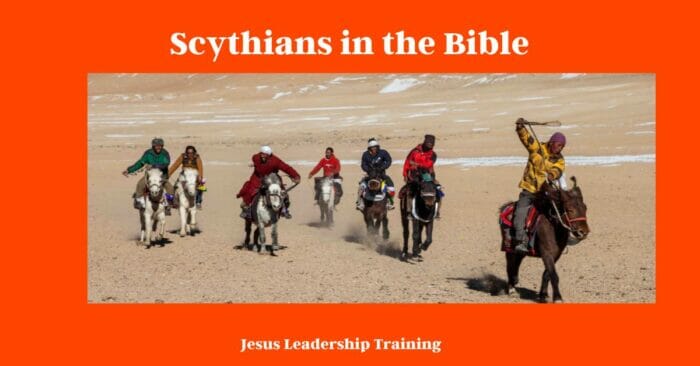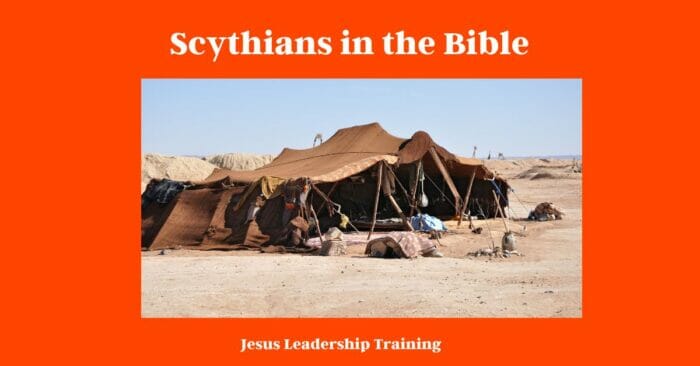Did you know that Scythians in the bible were actually one of the most powerful groups of people in the world at that time? They controlled a huge area of land and were known for their fierce warriors and horse-riding skills. In this blog post, we will take a closer look at Scythians in the bible(Biblical) and what they represented. We will also explore how they have been portrayed in popular culture over the years.
Table of Contents
Scythians in the Bible – Colossians
The Scythians were nomadic people who lived in the steppes of Central Asia, between the Black Sea and the Caspian Sea. They were mentioned one time in the Bible, in Colossians 3:11, which says, “Here there is no Gentile or Jew, circumcised or uncircumcised, barbarian, Scythian, slave or free, but Christ is all, and is in all.”
The Scythians were known for their skill in archery, and for their custom of tattoos. They were also known for their warlike nature, and for the way, they treated their enemies. When a Scythian warrior was captured by his enemies, he would be put into a bag and hung from a tree.
See Amazons Educational Resources for the Scythians
Then, his captors would shoot arrows at him until he was dead. The Scythians were fierce and ruthless people, but they were also considered to be among the most civilized people of their time.
“Colossians 3: 11 – Here there is no Gentile or Jew, circumcised or uncircumcised, barbarian, Scythian, slave or free, but Christ is all and is in all.” (Bible Verses) (New International Version)

What is the History of the Scythian?
The Scythians were a nomadic people who inhabited the steppes of Central Asia, stretching from the Black Sea to China. They were first mentioned in 8th century BCE by the Assyrian king Sargon II, who recorded their raids on his kingdom. The Greeks also had dealings with the Scythians, and they frequently clashed with the Persians.
The Scythians were excellent warriors, and they fought with a savage ferocity that terrified their enemies. In fact, the word “Scythian” eventually came to mean “barbarian.” The Scythians were proud and warlike people, and they lived by a strict code of honor.
They were also renowned for their skill in horsemanship, and they used their cavalry to great effect in battle. The Scythians continued to be a major power in Central Asia until they were conquered by the Macedonian king Alexander the Great in the 4th century BCE. Although they eventually disappeared as a people, the Scythians left a lasting impact on Central Asian culture.
What is the Culture of the Scythians?
The Scythians were nomadic people who lived in the steppes of Central Asia, stretching from the Black Sea to China. They were known for their mounted warriors, who were some of the most feared fighters in the ancient world.
The Scythians were also skilled metalworkers and artists, and their culture was greatly influenced by the Greeks. In fact, many of the most famous Scythian artifacts have been found in Greece, including the so-called “Scythian treasure” that was discovered in a royal tomb in Macedonia.
The Culture of the Scythians was one of great violence and bloodshed, but it was also a culture that produced some of the most beautiful art and craftsmanship of the ancient world.
What was the Religion of the Scythians?
The religion of the Scythians was a variant of the Pre-Zoroastrian Iranian religion. This religion differed from Zoroastrianism and the post-Zoroastrian Iranian religions and instead belonged to a more archaic stage of Indo-Iranian religious development than these other systems. The use of cannabis to induce trance and divination by soothsayers was a characteristic of the Scythian belief system.
The leading deity in the Scythian pantheon was Tabiti, whom Hērodotos compared to the Greek god Hestia. Tabiti was eventually replaced by Atar, the fire pantheon of Iranian tribes, and Agni, the fire deity of Indo-Aryans. Other deities mentioned by Hērodotos include Papaios, Api, Goitos

Describe the Family life of the Scythians.
Scythian women possessed little freedom and the society of the Scythians proper was patriarchal. The nomadic Scythian tribes lived primarily as pastoralists, and they raised horses, cattle, and sheep. The men spent their lives as horseback fighters since an early age, while the women and children spent their time in wagons where they lived.
What did the Scythians Dress like?
The Scythians were a nomadic people who lived in the Eurasian Steppe. They are believed to have worn padded and quilted leather trousers tucked into boots, and open tunics. Men seemed to have worn a variety of soft headgear—either conical like the one described by Herodotos, or rounder, more like a Phrygian cap.
Many archaeologists believe that the Scythians also used cannabis in their clothing. Cannabis was used in funerary rituals and men seem to have worn it in some form as headgear. It is possible that cannabis was also used to cleanse oneself in its smoke.
Scythian women wore long dresses and women belonging to the upper classes wore jewelry such as golden plaques.
How Many Tribes were there of Scythians?
There were four main tribes of Scythians, each with its own unique customs and ways of life.
- The Royal Scythians were the most powerful and controlled the other tribes.
- The Nomadic Scythians were a less powerful group who traveled west of the Royal Scythians.
- The Alazones were a tribe of farmers who lived in the steppe between the Dnieper and the Dnister Rivers.
- The Scythian Husbandmen was a less powerful tribe who lived to the north of the Royal Scythians.
Each tribe had its own unique customs and ways of life, which set them apart from the other tribes.

Who were the Cimmerians? Some experts believe the Same as the Free Scythians.
Cimmerians were nomadic people who lived in the steppes north of the Black Sea in antiquity. They were first mentioned in Assyrian records from the 8th century BCE as a group of nomads who raided Assyrian colonies in Asia Minor.
The Cimmerians were later mentioned by Greek historians such as Herodotus and Xenophon, who described them as warlike people who lived in tents and were expert horsemen. In the late 6th century BCE, the Cimmerians invaded the kingdom of Lydia in Asia Minor, defeating the Lydian king Croesus.
They then plundered their way across much of the Middle East, before being finally defeated by the Persian king Cyrus II in 559 BCE. Although little is known about them today, the Cimmerians were a significant force in the ancient world, and their raids and invasions helped to shape the history of the region.
Colossians and the Scythians (Barbarians)
Colossians is a book from the New Testament that was written to a specific group of people living in the city of Colossae. This group included both Jews and Gentiles who had come to believe in Jesus Christ.
In his letter, the apostle Paul warned them about false teachers who were promoting a different gospel. He also encouraged them to remain faithful to God and to live in unity with one another. One of the groups mentioned in Colossians is the Scythians. This was a nomadic people who lived on the steppes of Central Asia.
They were famous for their skill in archery and horsemanship. The Scythians were also known for their brutality, barbarians, and they often engaged in raids against their neighbors. Paul’s warning against false teachers would have been especially relevant for the Colossians, as they would have been vulnerable to the influence of the Scythians.
The Scythians had been known to inhabit areas of:
- Caspian Sea
- Caucasus Mountains
- Southern Russia
- North of Black Sea
- Asia Minor
Final Thoughts – Scythians in the Bible
Scythians were mentioned one time in the Bible. In the New Testament in the Letter to the Church on Colossae. They were Barbaric, Nomadic People that were part of the Roman Empire. History attributes them to the descendants of Japheth, in the Old Testament. Described as Uncircumcision Barbarian Scythian.
God Bless Greg


